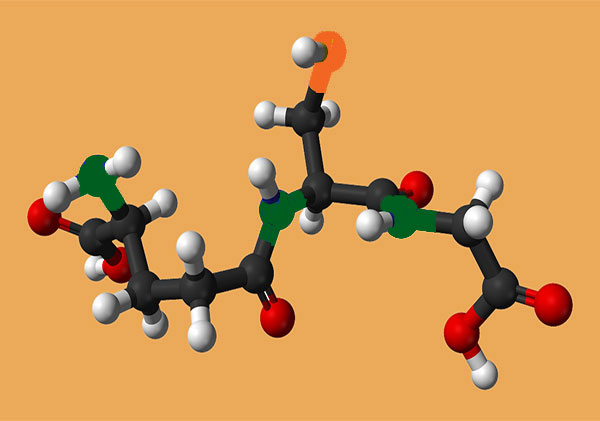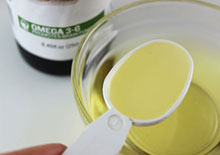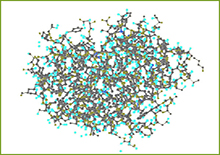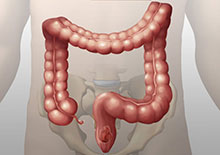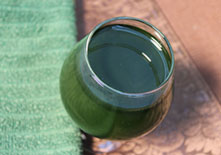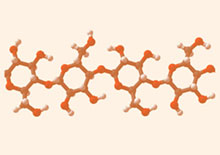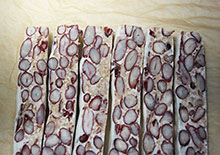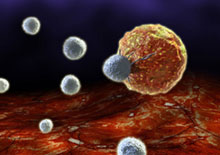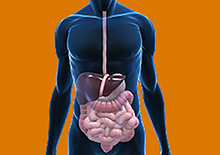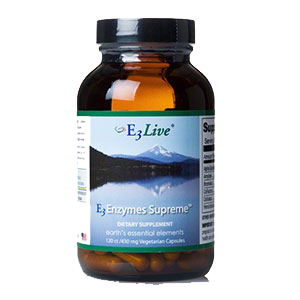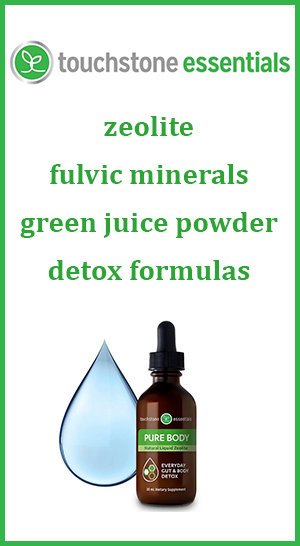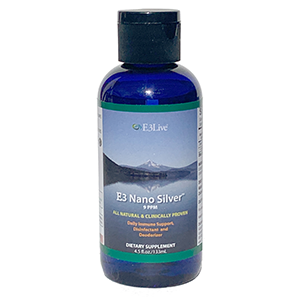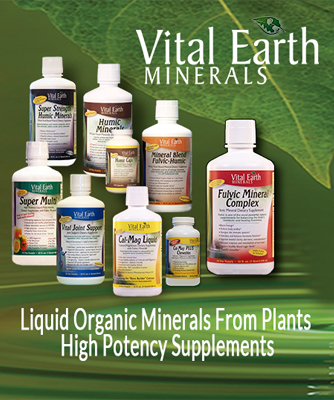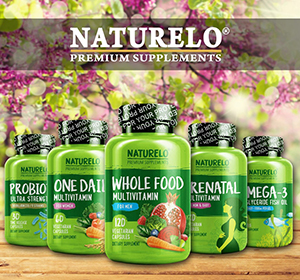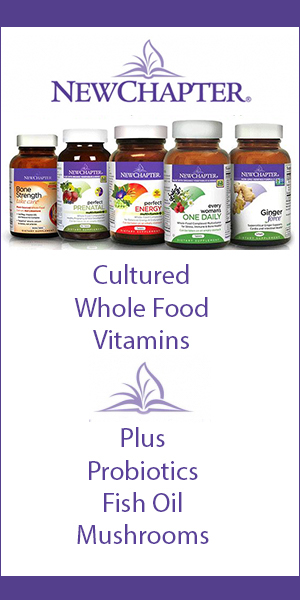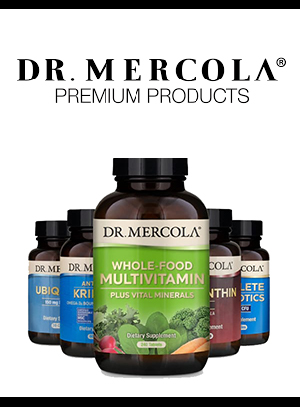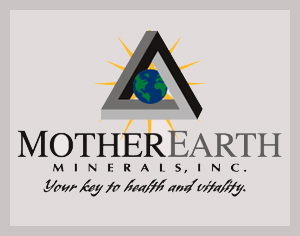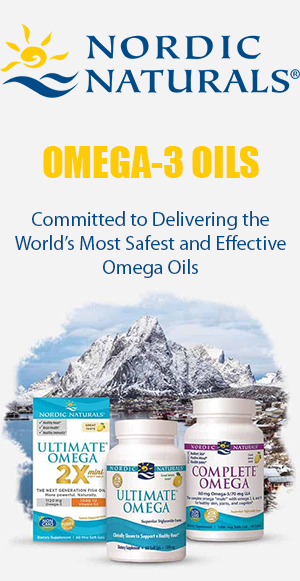A Basic Review of Dietary Minerals and A List of Food Sources
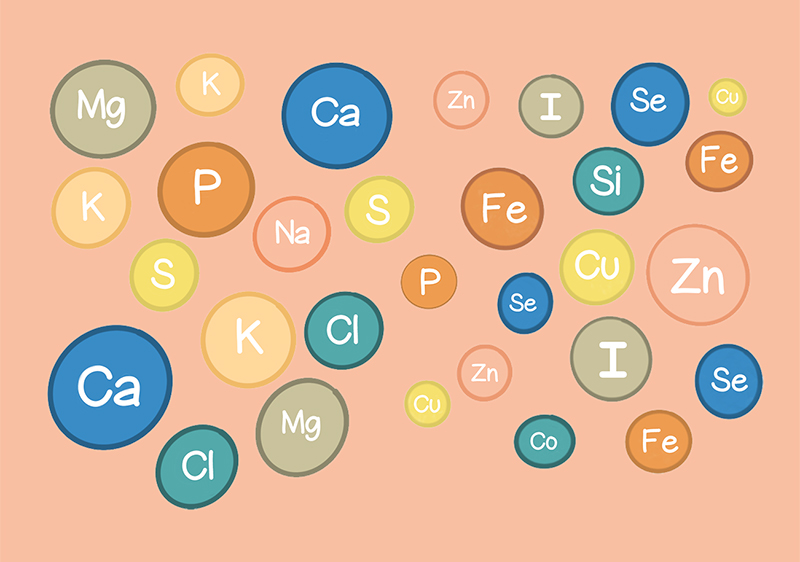
Dietary minerals are often referred to as the metabolic "spark plugs" of life energy that act as catalysts for the activation of many chemical reactions needed for normal bodily functions.
They are essential nutrients for human health responsible for assisting with and maintaining numerous biological tasks that are necessary for our existence.
They are the nutritional components found in the periodic table of elements and are naturally occurring substances present in the Earth's soil layer and water sources. Plants absorb these microscopic particles and make them bioavailable when consumed directly or by moving up the food chain.
Minerals are critical whether required in small or larger quantities as each plays a unique multifaceted role, performing on a variety of body processes.
Minerals aid in metabolism, energy production, fluid balance and bone strength, but they can likewise participate in many other ways to effectively sustain long-term health.
They can help to maintain acid/alkaline pH balance, regulate proper neurotransmission, aid in muscle contraction, facilitate the transfer of various nutrients and provide for appropriate cell permeability and tissue structure.
Many work in combination with enzymes, vitamins, hormones as well as help activate certain enzymatic antioxidants, like superoxide dismutase, catalase and glutathione.
We all need a sufficient supply of major minerals as part of a healthy diet plan to keep things running smoothly..
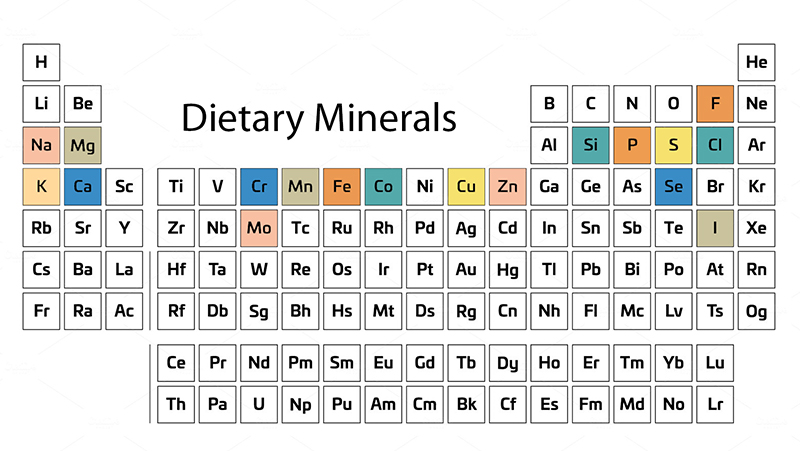
Macrominerals and Microminerals
There are over 70 mineral elements that can be utilized by the body to varying degrees. There are, however, only a handful of major and secondary varieties that are considered most significant for optimal well-being.
These are basically divided into two groups: macrominerals and microminerals. Although both are equally important, macrominerals are the main minerals the body needs in larger amounts as compared to microminerals, otherwise referred to as trace minerals, which are only needed in small portions.
Although most health experts, dietitians and nutritionists agree on the list of 7 main macrominerals, the class of microminerals needed by the body is somewhat controversial as research has not yet provided definitive evidence of their precise roles and functions.
Most agree on between 10-11 specific dietary trace minerals, but there are others like boron, chromium, tin, lithium and germanium that are also considered to be beneficial and hazardous to health when not present in the diet.
MACROMINERALS
calcium
magnesium
phosphorus
potassium
sodium
chloride
sulfur
MICROMINERALS
iodine
chromium
iron
copper
selenium
zinc
cobalt
manganese
silica
molybdenum
fluoride
The bulk of the major minerals or macrominerals found in the human body are calcium and phosphorous, which are mostly stored in the bones and teeth. The rest are present in lesser ratios in the fluids, bloodstream and tissues.
The quantity consumed daily through dietary sources is specific to one's age, gender and lifestyle activities. Some people may need more of certain minerals or when there is a mineral deficiency. This is the case for pregnant or nursing women, the elderly, vegans and those who make poor dietary food choices.
Mineral Testing and Deficiency Symptoms
The best way to learn about the minerals you may be currently lacking is to get tested by a qualified laboratory service. This is an important first step to correcting any mineral imbalance you may be experiencing. Some minerals work together, so an excess of one can also lead to a shortage of another. Testing is the sure fire way to know what you may need more or less of to provide for your unique requirements.
Here are some top signs of mineral deficiency that might help you decide whether to undergo further lab analysis.
Top Mineral Deficiency Symptoms:
- Muscle spasms or cramping, especially in the legs and feet
- Slow healing of wounds, cuts or bruises
- Ridges or white spots on the nails or thinning nails
- Brittle or thinning hair and abnormal excessive hair loss
- Foggy thinking, anxiety and depression
- Tooth decay and low bone density
- Candida overgrowth
- Chronic conditions like arthritis and osteoporosis
- Cravings for non-food substances like clay, dirt, paper or rubber
Mineral-Rich Food Sources
The best way to get the minerals your body needs is to eat a wide variety of foods. Each plant mines a different spectrum of minerals from the soil, which may provide more or less of any one mineral component.
To properly digest the minerals from the foods we eat, we need good stomach acid (or hydrochloric acid) which helps to activate digestive enzymes and the release of protein bound minerals.
Most minerals are predominantly absorbed into the bloodstream via the small intestine in a controlled manner, allowing for increased absorption in times of deficiency while also limiting absorption to prevent excessive intake.
It is good to be aware that some minerals are unavailable for proper assimilation when combine with certain foods high in phytotoxin compounds like oxalates, phytates or tannic acids.
Dietary minerals can be made more bioavailable for those with malabsorption issues through the intake of digestive enzyme supplements or probiotic-rich foods, like sauerkraut.
Best Mineral Supplements
The best mineral supplements deliver these essential macrominerals in a safe and bioavailable form within a whole food complex or as an ionic solution.
Concentrated ionically-charged solutions are often considered the easiest to absorb as they allow the mineral element to bond readily with water for quick and efficient uptake by the body.
It is important when considering calcium mineral supplementation to go for calcium citrate over calcium carbonate which can cause build-up in the body as well as digestive upset.

Top Superfoods High in Minerals
Leafy Vegetables and Green Juices - Some of the highest sources of mineral content can be found in dark green leafy vegetables, like kale, collard, spinach and wild green varieties. Leafy greens can be juiced as green juices for a potent mineral-abundant liquid or can be consumed raw in green smoothies or lightly steamed for highest nutritional value.
Seaweeds - While plants uptake minerals from the soils in which they grow, seaweeds absorb and concentrate them from highly mineralized seawater. They are one of the most mineral-rich plant-based foods on Earth and can be a valuable food source to integrate into one diet. Kelp seaweeds, like kombu and wakame, are some of the most nutritious available and can be added whole to soups and grains or used in powdered form. Other types like dulse and nori are additionally beneficial and can be more suitable for those sensitive to iodine excess.
Green Plant-Based Powders - These are nutrient condensed powders made from leafy green varieties as well as an assortment of sprouts, grasses and juice concentrates. Vitamineral Green by Healthforce Nutritionals is one of our personal favorites but there are many other quality brands available.
Nutritive Herbal Teas - There are several nutritive herbs available that are known to contain high quantities of certain minerals. These include nettle, horsetail, red raspberry leaf, red clover blossom and oatstraw. Creating tea infusions using different combinations of these herbal varieties can help to provide an immediately influx of minerals that are easily absorbed in liquid format.
Mineral and Sea Salts - Replacing table salt, a chemical known as sodium chloride that is devoid of minerals, with salts derived from sea or mineral sources can be an easy way to get more minerals into the diet. Celtic sea salt and pink Himalayan salt are two of the most popular and both contain wide spectrum of various trace minerals.
Superfoods - Some superfoods like shilajit contain at least 85 minerals in ionic form, in addition to humic acid and fulvic acid, nutrients often missing in the average diet. The microalgaes, like spirulina and marine phytoplankton, are also very high in mineral content.

List of Minerals and Vegan Food Sources
Calcium
Calcium is the most abundant mineral in the human body, largely found in the bones and teeth. It helps build and maintain the skeletal structure, regulates muscle contractions, is important for proper nerve transmission as well as supports healthy blood cell function and clotting.
Vitamin D is needed for the proper absorption of calcium. In addition, the body generally requires twice as much calcium as magnesium in the diet for the best uptake of these minerals. When this balance is thrown off deficiency can occur on either side.
The Recommended Dietary Allowance (RDA) for CALCIUM is 1300 mg/day for adults (based on a 2,000-calorie daily diet), but can be lower or higher depending on one's age or gender.
Greater amounts of calcium are required by women especially after menopause or when pregnant or breastfeeding.
Sources: raw dairy products like yogurt, kefir and cheeses, canned sardines and salmon, green leafy vegetables, tofu, seaweeds, almonds, oranges, broccoli, carob, spirulina, herbal teas like chamomile, nettle and oatstraw.
Chloride
Chloride, also an electrolyte, has a negative charge that works with sodium and potassium to maintain a healthy balance of bodily fluids. It is an essential macromineral needed for hydrochloric acid production and the digestive juices that initially break down food in the stomach.
It also assists in regulating normal pH levels and important for proper kidney function.
Chloride is mostly consumed via salt intake and any excess is excreted by the body.
The Recommended Dietary Allowance (RDA) for chloride is 2300 mg/day for adults (based on a 2,000-calorie daily diet), but can be lower or higher depending on one's age or gender.
Sources: pink salt, sea salt, olives, celery, leafy greens and seaweeds.
Chromium
Chromium is a trace element known to enhance the action of the hormone insulin and the metabolism of proteins, fats and starches. It is involved in metabolic processes that are needed to regulate blood sugar and glucose transport and uptake.
The Recommended Dietary Allowance (RDA) for chromium is between 25 mg -35 mg a day for adults, but can be lower or higher depending on one's age or gender.
Sources: broccoli sprouts, horsetail, legumes, mushrooms, marine phytoplankton, mung bean sprouts, nettles, nuts and seeds, oatstraw tea, red clover tea, red raspberry leaf tea, rye sprouts and whole grains.
Copper
Copper is required in trace amounts for the formation of red blood cells as well as for the absorption and synthesis of iron. It is important for various enzymatic reactions, bone maintenance and is a necessary nutrient for tissue repair as it stimulates immune functions and is involved elastin and collagen development. Copper is one of the trace nutrients that plays a role in production of enzymatic antioxidants.
The Recommended Dietary Allowance (RDA) for copper is 0.900 mg a day for adults, but can be lower or higher depending on one's age and gender.
Sources: cashews, sesame seeds, legumes, blue-green algae, cacao beans, goji, green leafy vegetables, mushrooms, marine phytoplankton, miso, seaweeds, shiitake, fenugreek sprouts, sunflower sprouts, spinach, tempeh and wheatgrass.
Fluoride
Small amounts of fluoride strengthen the bones, harden the teeth, build immunity to infections. In concentrated amounts, however, fluoride is toxic to the body and should never be consumed in supplement form. There are many health experts who believe it should not be put in municipal drinking water for this reason.
The Recommended Dietary Allowance (RDA) for fluoride is 4 mg a day for adults, but can be lower or higher depending on one's age and gender.
Sources: blue-green algae, garlic, lemons, limes, radish sprouts, rye sprouts, and seaweeds.
Iodine
Iodine is an essential mineral nutrient for proper metabolic processes, healthy thyroid function and its hormone production. It helps to prevent goiter and the uptake of radioactive iodine from external or atmospheric sources.
The Recommended Dietary Allowance (RDA) for iodine is 0.150 mg a day for adults, but can be lower or higher depending on one's age and gender.
Sources: dulse, nori, kelp, blue-green algae, bee pollen, cranberries, green leafy vegetables, onions, sesame seeds, spirulina, sea salt, and watercress.
Iron
Iron is an essential part of hemoglobin and the transportation of oxygen to the cells of the body. It is required for many enzymes and proteins and known to build strength, enhance energy and prevent anemia. Iron is one of the trace nutrients that plays a role in production of enzymatic antioxidants.
The Recommended Dietary Allowance (RDA) for iron is 18 mg a day for adults, but can be lower or higher depending on one's age and gender.
Sources: blue-green algae, dandelion root, chlorella, cacao beans, collards, burdock, beets, figs, dulse, green leafy vegetables, goji berries, kale, kelp, marine phytoplankton, miso, nettles, olives, red raspberry leaf tea, seaweeds, spirulina, sesame seeds, and spinach.
Manganese
Manganese is an important co-factor in enzyme activation and production and helps to increase amounts of certain enzymatic antioxidants. Small amounts of manganese contribute to maintaining healthy bones and cartilage. It is also beneficial to nervous system functions and assists in the utilization of vitamin C.
The Recommended Dietary Allowance (RDA) for manganese is 2.3 mg a day for adults, but can be lower or higher depending on one's age and gender.
Sources: alfalfa, bee pollen, cacao, chickweed, coconut water, dandelion, dock, green leafy vegetables, garbanzo bean, kelp, miso, nettles, nuts and seeds, raspberry leaf tea, strawberries, seaweed and tempeh.
Magnesium
Magnesium works alongside calcium and is crucial for healthy nerve function, muscular contractions and relaxation as well as plays a significant role in bone and teeth formation.
Magnesium helps to regulate blood pressure, normalizes the heart rate, assists in many enzymatic processes, DNA synthesis, and contributes to cellular energy production.
Adequate magnesium levels also are necessary for the efficient delivery of calcium and potassium across cell membranes.
The Recommended Dietary Allowance (RDA) for magnesium is 420 mg/day for adults (based on a 2,000-calorie daily diet), but can be lower or higher depending on one's age or gender.
Sources: green leafy vegetables, chia seeds, avocados, pumpkin seeds, almonds, brown rice, oatmeal, salmon, black beans, dark chocolate, peanut butter and herbals teas like nettle, alfalfa, red clover, horsetail, chamomile and dandelion root.
Potassium
Potassium is a mineral most well-known as a positively charged electrolyte needed for proper cellular fluid balance, working alongside the two other macrominerals sodium and chloride.
It is also necessary for maintaining normal blood pressure, balancing the acid/alkaline levels of the body pH, involved in nutrient transport, cardiac functions, muscle contractions and nerve transmissions.
The Recommended Dietary Allowance (RDA) for potassium is 4700 mg/day for adults (based on a 2,000-calorie daily diet), but can be lower or higher depending on one's age or gender.
Sources: avocados, bananas, legumes, cabbage, dulse, figs, green leafy vegetables, horsetail, mushrooms, nettles, pea shoots, potatoes, red clover, sprouts, squash, red peppers and spinach.
Phosphorus
Phosphorus is the second most abundant mineral in the human body after calcium. Phosphorus is a part of our DNA and ATP and is an important component of the skeletal structure and works with calcium to provide strong bones and teeth.
It is required for the synthesis of certain B vitamins, like riboflavin and niacin, and assists in muscle and vascular contractions. Adequate amounts of phosphorus are essential for energy metabolism as well as for the overall growth and repair of bodily tissues.
Phosphorus supports protein synthesis, cell signaling, kidney functions and nerve transmission.
Too much phosphorus in the diet can throw off calcium levels.
The Recommended Dietary Allowance (RDA) for phosphorus is 700 mg/day for adults (based on a 2,000-calorie daily diet), but can be lower or higher depending on one's age or gender.
Sources: dairy products, meat, poultry, seafood, legumes, spirulina, brazil nuts, hemp seeds and whole grains.
Selenium
Selenium is another mineral essential for bone growth and is one of the trace nutrients that plays a role in production of enzymatic antioxidants. Adequate amounts of selenium are necessary for the health of the thyroid gland and are additionally helpful for increasing pancreatic function and tissue elasticity.
The Recommended Dietary Allowance (RDA) for selenium is 0.055 mg a day for adults, but can be lower or higher depending on one's age and gender.
Sources: alfalfa leaf, brazil nuts, burdock root, cabbage, chickweed, fennel, fenugreek sprouts, goji, ginseng, raw honey, horsetail, green leafy vegetables, oatstraw, marine phytoplankton, mushrooms, raspberry leaf, seaweeds, and sprouts.
Silica
Silicon (or silica) is the second most abundant mineral in the Earth's crust layer and helps to produce strong bones, cartilage, tendons and blood vessels. It is necessary for the synthesis of elastin and collagen needed for healthy joints, nails, hair and skin. While silica is often not officially listed as a micromineral, we believe it is an important element to nutrition basics.
There is no Recommended Dietary Allowance (RDA) for silica as it is only needed in small amounts usually present in the average diet.
Sources: alfalfa sprouts, bamboo, burdock, cauliflower, celery, cucumbers, green leafy vegetables, hemp seeds, horsetail, leeks, kelp, oatstraw tea, wild rice, and wheatgrass.
Sodium
Along with potassium and chloride, sodium is one of the three main electrolyte minerals. Sodium is essential for the body’s electrical conductivity and ATP. It helps regulate the movement of nutrients and fluids in and out of cells and promotes the balance of positive and negative ions in the body fluids and tissues.
It also supports hydrochloric acid production, nerve impulses, muscle contractions, heart rate and balanced blood pressure levels. Too much sodium intake, however, can increase blood pressure in some individuals and throw off the ratio of potassium in the body.
The upper Recommended Dietary Allowance (RDA) for sodium is 2300 mg/day for adults (based on a 2,000-calorie daily diet), but can be lower depending on one's age, gender or health conditions. A lower RDA of 1,500 mg/day might be more suitable for some people.
Sources: pink salt, sea salt, celery juice, dark leafy greens, olives, miso, seaweeds and soy sauce.
Sulfur
Next to calcium and phosphorous, sulfur is the third most plentiful mineral in the body. It is found in the muscles, bones and skin, but plays an important part in many bodily systems.
Sulfur bonds are required for proteins and are necessary for the proper activity and structure of enzymes needed for metabolic processes and DNA repair. It is an important element for healthy skin, helping to improve elasticity, tissue regeneration and is additionally rebuilding to tendons, ligaments and muscles after injury.
Sometimes this macromineral is left off the list of top major minerals, but it is an important one nonetheless.
Although sulfur is an essential dietary component required by the body, there is no Recommended Dietary Allowance (RDA) for the mineral. It is typically found in abundance in protein-rich diet as it is a component of the two amino acids methionine and cysteine.
Sources: eggs, meat, poultry, legumes, garlic, spirulina, kelp, MSM, hemp seeds, nuts, cruciferous vegetables, onions, durian and green leafy vegetables.
Zinc
Zinc assists in energy metabolism, provides for the generation of sex hormones and is nourishing to the prostate gland. Zinc is needed for the production of numerous enzymes and is another one of the trace nutrients that plays a role in production of enzymatic antioxidants. Zinc is important for the immune system as well as cell regeneration, tissue grow and repair and is required for DNA synthesis.
The Recommended Dietary Allowance (RDA) for zinc is 11 mg a day for adults, but can be lower or higher depending on one's age and gender.
Sources: alfalfa leaf, beans, bee pollen, burdock, cacao, kelp, goji, green leafy vegetables, marine phytoplankton, milk thistle seeds, mushrooms, miso, nettles, nuts and seeds, onions, pumpkin seeds, sarsaparilla, spirulina, and sprouts.
Demineralization and Soil Depletion
The mineral quality of our food consumed is determined by the quality of the soils in which the food was grown. When garden growing or sprouting your own foods, this process is more easily controlled.
However, most food grown on a mass produced agricultural level is not usually coming from high quality soil that rich in natural mineral content, but rather utilizes conventional means employing the use of chemical fertilizers and pesticides.
Aggressive farming practices over the last several decades have brought many of the earth's minerals to the surface where they are washed away. Man-made fertilizers unnaturally boost plant growth, but the variety of macrominerals and trace minerals needed to support life are not replenished.
The best ways to ensure your foods are of a high nutritional density is either grow them yourself or buy them directly from your local farmer's market where you can inquire about farming methods employed. When growing your own foods consider using rock dust primer, ocean water solution or seaweeds, like kelp, to naturally fertilize the soil.
While organically grown foods can be much higher in nutritive value than commercially grown foods, this is not always the case. Mineral quality really depends on the integrity of the company you are dealing with, not all organically grown manufacturers are intent on replenishing the full spectrum of minerals that are lost through monocrop farming.
For more information on the topic of soil remineralization visit the website "Remineralize the Earth."
Precautions:
It is important to be aware that excessive intake of some mineral supplements, like calcium, iodine and iron, can also cause negative health impacts in some cases. When taking mineral supplements it is recommended to seek the advice of a medical physician, especially if you are pregnant, nursing, taking prescribed medications or have a serious health condition.
